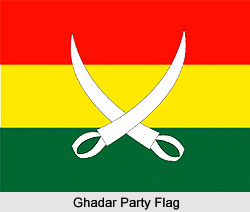 Ghadar Party was established by the Punjabi Sikhs of the United States and Canada in June 1913. The main aim of the party was to free India from the British Rule. Ghadar Party was also known as the Hindi Association of the Pacific Coast. The word `Ghadar` literary means "mutiny" or "rebellion" or "revolt". It is an Urdu/Punjabi word. On 1st November 1913, Ghadr issued their first paper from University of California in Berkeley. The founding member of the party, Lala Hardayal, wrote in the first issue, "Today there begins `Ghadar` in foreign lands, but in our country`s tongue, a war against the British Raj. What is our name? Mutiny. What is our work? Mutiny. Where will mutiny break out? In India. The time will soon come when rifles and blood will take the place of pens and ink." Ghadar party was originally built around the weekly paper The Ghadar. The paper carried the caption on the masthead: Angrezi Raj Ka Dushman (an enemy of the British rule).
Ghadar Party was established by the Punjabi Sikhs of the United States and Canada in June 1913. The main aim of the party was to free India from the British Rule. Ghadar Party was also known as the Hindi Association of the Pacific Coast. The word `Ghadar` literary means "mutiny" or "rebellion" or "revolt". It is an Urdu/Punjabi word. On 1st November 1913, Ghadr issued their first paper from University of California in Berkeley. The founding member of the party, Lala Hardayal, wrote in the first issue, "Today there begins `Ghadar` in foreign lands, but in our country`s tongue, a war against the British Raj. What is our name? Mutiny. What is our work? Mutiny. Where will mutiny break out? In India. The time will soon come when rifles and blood will take the place of pens and ink." Ghadar party was originally built around the weekly paper The Ghadar. The paper carried the caption on the masthead: Angrezi Raj Ka Dushman (an enemy of the British rule).
Ghadar party`s ideology was secular in its strong sense. According to Sohan Singh Bhakna, "We were not Sikhs or Punjabis. Our religion was patriotism". Later on Sohan Singh Bhakna became a major peasant leader in Punjab. In 1914, following the voyage of the Komagata Maru, many Indian residents in the USA sold their business and homes to drive the British away from India. Komagata Maru was a Japanese steam liner that used to sail from Hong Kong to Shanghai, China, Yokohama, Japan, and then to Vancouver, British Columbia, Canada. 376 passengers were travelling from Punjab, India in 1914, who were not allowed to land in Canada and the ship was coerced to return to India. 340 Sikhs, 24 Muslims, and 12 Hindus were travelling in the ship. Voyage of the Komagata Maru was imprinted as the most infamous incident in the history of early 20th century-- the exception laws in Canada and the United States designed to keep out immigrants of Asian origin.
Key personalities like Hardayal had fled to Europe, worried that the US authorities would hand him over to the British. Sohan Singh Bhakna was already in British hands, thus the leadership fell in the hamds of Ram Chandra. The organisation limited themselves in the USA, after Canada`s entry into World War I. At this point of time the German Government delivered substantial funding. The party also possessed a very militant tone like, `No pundits or mullahs do we need, No prayer or litanies recite. These will only scuttle our boat; Draw the sword, it`s time to fight! Hindus, Muslims, Sikhs though we be Sons of Bharat are we still. Postpone your prayers to another time; The call of the hour is to kill!`.
Under the leadership of Jwala Singh, another 61 Ghadarites sailed from San Francisco, via Korea, Canton and Singapore. They were aimimg tostart the uprising in India. Over a hundred others, including British spies also joined the journey, but all of them were arrested as they arrived. The Ghadar Party from the very beginning wished the arrival of the First World War. The Germans using Indian dissatisfaction also thought of disrupting the British Empire. An article, the Berliner Tageblatt was published in Engalnd`s India Troubles on March 1914. The article described the ways how Indian nationalist secret societies were expanding; with specific mention of California.
The Ghadar Party during World War I, backed Indian deserters from the British Army in Mesopotamia. Ghadar Party came into prominence during the second decade of the 20th century. Members of the Ghadar party undertook `political terrorism`. This term was coined by the British government. The political terrorism to many Indians was an act of revolution. Terrorist activities of the Ghadar party included bombing planted on government property and aimed assassinations of British and police officials.
The British government commenced the first Lahore Conspiracy Case in response to these activities in 1915. The case witnesed more than two dozen youth sentenced to death, including Kartar Singh Sarabha and hundreds of others to life imprisonment. Many others were given heavy jail sentences in order to inhibit their movements. The Lahore Conspiracy Case is said to have determined many revolutionaries of the area, namely Bhagat Singh. In 1917, some prominent leaders of the Ghadar Party were arrested and put under judgement in the Hindu German Conspiracy Trial, in which their paper was cited.
The Ghadar party commanded loyal admirers in the province of Punjab, but most salient activists were pushed into deportation in Canada and the United States. Thus it discontinued to play an active role in Indian politics after 1919. The party had dynamic members in other countries such as Mexico, Japan, China, Singapore, Thailand, Philippines, Malaya, Indo-China, Eastern and Southern Africa. Some prominent leaders of the Ghadar party were Kartar Singh Sarabha, Lala Har Dayal and Tarak Nath Das.



















